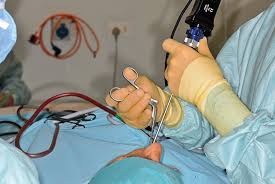Laparoscopic surgery, also known as minimally invasive surgery, has transformed the field of surgery by enabling procedures through small incisions with the aid of a camera and specialized instruments. The evolution of this technique is a fascinating journey marked by significant milestones and technological advancements. For more detail visit our site(وضع بالون المعدة بالمنظار في الرياض) Here’s a comprehensive overview of the history and development of laparoscopic surgery.

Early Beginnings
- 1901: Georg Kelling: German surgeon Georg Kelling performed the first laparoscopic procedure on a dog, which he called "celioscopy." He used a cystoscope to examine the abdominal cavity.
- 1910: Hans Christian Jacobaeus: Swedish internist Hans Christian Jacobaeus is credited with performing the first human laparoscopy and thoracoscopy, using a cystoscope to inspect the abdominal and thoracic cavities.
Technological Advancements
- 1930s-1940s: Improvements in endoscopic technology continued, but the procedures were primarily diagnostic due to limitations in lighting and visualization.
- 1950s: The development of fiber optics revolutionized endoscopy. Harold Hopkins invented the rod-lens system, which improved image quality and allowed for better illumination and visualization.
The Birth of Modern Laparoscopic Surgery
- 1970s: Gynecologists, including Patrick Steptoe, advanced the use of laparoscopy for diagnostic purposes and infertility treatments. The technique began gaining acceptance for minor surgical interventions.
- 1980: Kurt Semm: German gynecologist Kurt Semm performed the first laparoscopic appendectomy in 1980, demonstrating the feasibility of using laparoscopy for therapeutic procedures.
Major Milestones in the 1980s and 1990s
- 1985: Erich Mühe: German surgeon Erich Mühe performed the first laparoscopic cholecystectomy (gallbladder removal), which marked a significant milestone in the acceptance of laparoscopic surgery for major procedures.
- Late 1980s: The introduction of video cameras attached to laparoscopes allowed surgeons to view the surgical field on a monitor, greatly enhancing precision and control.
- 1990s: Laparoscopic techniques expanded rapidly across various surgical fields. Procedures such as laparoscopic hernia repair, hysterectomy, and colorectal surgery became increasingly common.
Expansion and Acceptance
- Early 2000s: The development of more advanced instruments, including articulating instruments and better energy devices (e.g., ultrasonic scalpels, bipolar diathermy), further enhanced the capabilities of laparoscopic surgery.
- Robotic Surgery: The introduction of robotic-assisted laparoscopic surgery, such as the da Vinci Surgical System, provided greater dexterity, precision, and control, allowing for more complex procedures to be performed minimally invasively.
Recent Advances and Future Directions
- Enhanced Imaging: The development of high-definition and 3D imaging has significantly improved visualization during laparoscopic procedures, making surgery safer and more effective.
- Single-Port Surgery: Innovations such as single-incision laparoscopic surgery (SILS) reduce the number of incisions required, further minimizing scarring and recovery time.
- Natural Orifice Transluminal Endoscopic Surgery (NOTES): This emerging technique involves accessing the abdominal cavity through natural orifices, such as the mouth or vagina, eliminating the need for external incisions.
Impact on Surgical Practice
- Reduced Morbidity and Mortality: The minimally invasive nature of laparoscopic surgery reduces the risk of complications, shortens hospital stays, and speeds up recovery.
- Widespread Acceptance: Today, laparoscopic surgery is the standard of care for many procedures. Surgeons receive specialized training in minimally invasive techniques, and patients often prefer laparoscopic options due to the numerous benefits.
Conclusion
The history and development of laparoscopic surgery reflect a remarkable journey of innovation and improvement in surgical practice. From its early experimental stages to its current status as a cornerstone of modern surgery, laparoscopic surgery has transformed the landscape of surgical care. With ongoing advancements in technology and technique, the future of laparoscopic surgery holds even greater promise for improving patient outcomes and expanding the possibilities of minimally invasive surgery.
